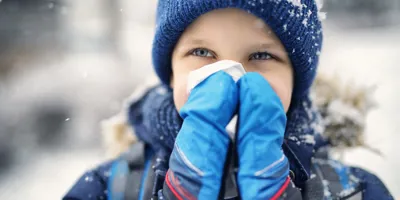67 people found this helpful

Between packed lunches for the kids, that important pitch at work, and the infamous chair of laundry at home, you didn’t get a second for yourself this week. And now, you’re starting to feel a little run down. Well, this could be your sign to slow down and take a moment for yourself. While it might sound like the beginnings of a nasty cold, did you know that you could well be suffering from sinusitis without a cold?
Sinusitis and cold symptoms can be very similar, so it’s easy to assume that the two are interchangeable. But you know what’s not so easily confused? The importance of taking a well-earned rest when you’re unwell. The grocery shopping, the cooking, the emails and the chores can all wait, especially if you’re going down with symptoms of sinusitis! You give so much to everyone else, every day; don’t forget to give as much to yourself once in a while.
Keep on reading to get clued up on the symptoms of sinusitis and of a cold, and their similarities and differences. Discover whether it’s possible to get sinusitis without a cold, and our top tips for getting some relief and looking after number one. After all, you’re no good to anyone else until you’re good to yourself first.
Cold and sinusitis symptoms
Before answering whether it’s possible to have sinusitis without a cold, let’s quickly go back to what a cold and sinusitis are, and their main symptoms.
A cold, also known as the common cold, is a viral infection of your nose and throat. Symptoms of a cold can include:
- A runny and stuffy nose
- A sore throat
- Coughing
- Sneezing
- Headaches
- Fever
- Body aches.1
Now, what is sinusitis? Sinusitis, or a sinus infection, occurs when the sinuses – the air-filled cavities around your nasal passages – become inflamed, swollen, and filled with fluid. This inflammation is often the result of complications of a viral infection such as a cold.3 Here are the most common symptoms of sinusitis:
- Pain and pressure in the face, particularly around the nose, eyes, or forehead
- A blocked nose
- Headaches
- Toothaches
- Mucus that may be yellow or green
- Reduced sense of smell and taste
- Coughing
- Feeling of pressure in the ears
- High fever.3
These symptoms aren’t pleasant, so it’s perfectly understandable that you feel like curling up in bed all morning (even if reality insists you’re on your feet first thing, whipping up a five-star breakfast in the kitchen). But the kids can make their own pancakes, this time. And you can pull your duvet up high, sink back, and relax into those feathery pillows, for five more magical minutes. They’ll be fine.
Cold and sinusitis similarities
It’s natural to assume that sinusitis goes hand in hand with a cold. After all, many of the symptoms are the same. However, sinusitis is often caused by a common cold that has progressed. Typical symptoms of a cold that you might also experience with sinusitis include:
- Blocked nose
- Excess mucus
- Headache
- Cough
- Fatigue
- Fever.1,3
We know what it’s like. Life can be so busy; you so often forget to look after yourself. But everyone deserves a little treat, once in a while, especially when you’re sick! Claim back a little luxury for yourself with Cushelle Quilted toilet paper for the indulgent me-time moment that you deserve – once, twice, or maybe even three times a day.
So, does that mean that sinusitis and a cold always go together? The answer is, no. You may well have sinusitis without a cold, and there are actually some key differences between the two conditions.
Sinusitis or cold? Differences between a cold and sinusitis
While both conditions can look similar at first glance, sinusitis has additional symptoms such as a high fever, facial pain and yellow and green mucus, and is more severe and lasts longer than the common cold. The common cold is usually harmless and should get better on its own after a few days, whereas sinusitis can take up to 4 weeks to go away.1,3
The two conditions also differ in the way they are spread. Colds are highly contagious and can be spread through droplets in the air when someone who is sick coughs, sneezes, or talks.2 You can also get a cold by touching surfaces or objects that have the virus on them and then touching your face.
Sinusitis is not considered contagious in itself, but the causes of sinusitis can be. If sinusitis is caused as a result of having a viral infection for instance, that virus could have been spread through droplets.4 So, whether you suffer from a cold or a sinus infection, it’s important to prevent the spread of germs by practising good hygiene habits to protect yourself and those around you.
Knowing the differences between a cold and sinusitis is important to understand the symptoms you’re experiencing and seek the appropriate care. If symptoms persist or worsen, it's time to consult a healthcare provider to determine the best course of action.
Can you get sinusitis without a cold?
While a cold can progress into sinusitis, it's not the only condition that causes a sinus infection, and it's possible to get sinusitis without a cold! It's completely possible to experience symptoms like a sinus headache, but no cold symptoms.
Here are some other causes of sinusitis apart from the common cold:
- Other viral infections like the flu
- A fungal infection
- A bacterial infection
- An infected tooth
- Allergies.3,5
So, next time you have sinusitis, don’t just automatically assume that you have a cold as sometimes, you can get a sinus infection with no cold! Thankfully, there are a few ways you can treat sinusitis without a cold. Keep reading to learn about sinus infection remedies.
Sinusitis without a cold: treatments
Sinusitis usually clears up on its own in two to four weeks, but there’s no harm in looking for some home remedies for a sinus infection. After all, a sinus infection can be very unpleasant and tiring.
There are a few ways to ease the symptoms of sinusitis without a cold:
- Drink a lot of fluids. If you’re not feeding the kids, you’re cooking for your partner. And if you’re not cooking for your partner, you’re grocery shopping for the weekend. But amidst the madness, you deserve a treat too! Besides, staying hydrated is key to recovering quickly! When you’re sick, you can lose more fluids than usual (through sweating, nose blowing, diarrhoea and vomiting).6 So, stock up on your hydrating tipple of choice, grab the chocolatey goodies, and head back to bed – we've heard there are great takeaway options for the kids, anyway.
Next time you go grocery shopping, treat yourself toCushelle Quilted toilet paper. You rarely get time for yourself, so when you do find a moment to lock yourself away and exhale, it’s important to make the most of it. After all, you – and your behind – deserve the best.
- Rest. Taking it easy and resting properly should also help you to feel better.
- Inhale steam. The key to relieving the symptoms of sinusitis without a cold is using treatments that break down the congestion in the sinuses.7 This can be done by leaning over a bowl of hot water and breathing in the steam for a few minutes at a time, a few times a day. Or, hear us out... Why not treat yourself to a spa day? Hitting the sauna might just help clear your sinuses, as well as provide a welcome break from the bustle of everyday. The work report, the laundry – it can all wait. You deserve to pamper yourself.
- Use nasal decongestant sprays to unblock your nose.3 Your pharmacist will be able to advise on which decongestant to use. Keep in mind that children below the age of six should not use decongestants.3
You now know more about sinus infection without a cold, symptoms of sinusitis, and how you can get some relief with our sinusitis treatments at home. So, with these answers, you can now identify whether you’re suffering from a cold, a cold with sinusitis, or sinusitis without a cold, and treat your symptoms. The secret to a speedy recovery? Putting yourself first. There’s nothing wrong with doing that from time to time, when so much of your efforts go to others. So, take a break, focus on yourself and your needs – the rest can wait.
If your symptoms get worse, are severe, or don’t get better after a week, contact a medical professional who will be able to advise.
*To verify claims, please email verify.uk@essity.com for full verification details.
Sources:
2 Johns Hopkins Medicine, “Common cold”
3 NHS, “Sinusitis (sinus infection)”
4 Penn Medicine, “Clearing the air: is sinusitis contagious or just a common cold?”
Related articles
Sleeping with a cold: how to get rid of a blocked nose at night
Discover some of the best ways to deal with a blocked nose at night. Find our simple home remedies here plus tips on the best way to sleep with a blocked nose.

Cold and Flu: What’s the Difference?
What is the difference between a cold and the flu? Find out how cold and flu symptoms differ, and the answer to the age-old question: ‘have I got a cold or flu?’

How to relieve watery eyes during a cold
When you’ve got watery eyes and a cold you can find some relief. Discover our tips on dealing with a runny eyes with a cold, here.

How to know the difference between allergies and a cold
What’s the difference between a cold and allergies? They both involve runny noses and sneezing! Here’s how to know the difference between a cold and allergies.

Debunking 'man flu' in 3 arguments
Have you ever wondered whether man flu exists or not? Find three key arguments that suggest that man flu may well be a real thing, here.

Child with a cold? Discover 7 effective cold remedies for toddlers
Find out what to do when your baby has a cold. Use our 7 home remedies for baby cough and chest congestion to provide comfort and help them feel better.



